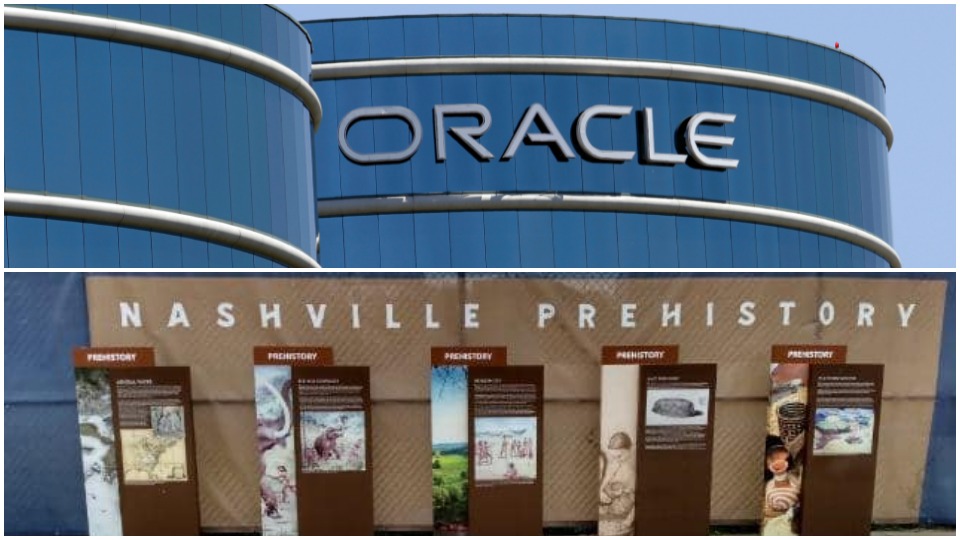
NASHVILLE—For several months beginning in the fall, the Native community and its allies have been conducting a campaign to slow down the urban development of the East Bank of the Cumberland River that flows through Nashville. The East Bank is being slated for development by the Oracle Corporation and its associated businesses.
The East Bank and all of downtown Nashville sit atop the remains of a vast, ancient Native American city that flourished here several centuries ago. Indeed, this ancient metropolis had an estimated population of 400,000 in the 14th century. This was during what is called the Mississippian Period of Native American history, which covered the present-day Eastern, Southeastern, and Midwestern United States. Taking into account the surrounding suburbs of towns, villages, hamlets, and farmsteads, the total population of Middle Tennessee was thought to be over one million, making for the largest Indigenous population in all the Southeast.

At this time in history, the ancient metropolis and its suburbs had a population larger than that of Paris, France, at 500,000, London, England, at 200,000, or the Aztec capital of Tenochtitlan at 200,000. By the 15th century, the populations of ancient Nashville and its surrounding areas had mysteriously disappeared. The huge populations were astonishingly absent.
The discovery of the ancient city
The discovery of the ancient metropolis came to light when excavation was being done for the construction of the Sounds Baseball Stadium at the old Sulphur Dell baseball park site in 2014. Efforts by the Indigenous community and the historic preservation community, represented by the American Indian Coalition (AIC) and the Tennessee Ancient Sites Conservancy (TASC) respectively, fostered an archaeological excavation for the new Sounds stadium that brought to the surface evidence of a huge Native American metropolis that 900 years ago stood where downtown Nashville now sits.
Remains of this ancient Native American Indigenous city lie layers beneath the pavement and buildings of modern-day Nashville. From downtown Nashville and directly to the east across the Cumberland River once stood a flourishing, bustling city with tens of thousands of inhabitants. This huge metropolis was the center of a brilliant Indigenous civilization that blossomed in the area between 800 to 1500 CE (Common Era). This era also included the earthworks cities of Cahokia in Illinois, Moundville in Alabama, and Spiro in Oklahoma, to cite a few of the known ancient urban centers.
Ancient Nashville was the center of a huge salt making industry, as indicated by the very large pottery vessels uncovered called contemporarily “salt pans.” The manufacture of salt was so prodigious that the mineral was traded as a commodity throughout the entire Southeast.
The ancient city and its environs also abounded in its production of eating implements, particularly spoons and forks, at a time when most of the rest of the world was still eating with its fingers. In fact, the first known “spork,” a combination spoon and fork, in human history originated in the Cumberland Valley, antedating all other such implements made for table use.
The ancient metropole is locally called “Salttown” and the “Buried City.” Currently, the archaeological sites are in jeopardy from the onslaught of development.
When the first European settlers arrived in Middle Tennessee in 1779, they were amazed at the many huge mounds that abounded in the area. There were over 80 such earthworks in the Nashville area alone. There were temple mounds, burial mounds, and mounds for the residences of the leadership of the vast Indigenous complex of ancient cities, towns, villages, hamlets, and farmsteads.
Most of the mounds of Davidson County, which encompasses modern Nashville, have fallen prey to the housing, entertainment, and industrial development of a latter-day 20th-century urban boom.
Also, mention must be made of the destruction wrought in 2016 by the sly and rapid construction of the Top Golf entertainment complex on the East Bank. Top Golf sits squarely on top of several Mississippian mounds. This development “slipped through the cracks” so to speak, as those who would have organized opposition to the construction were that year covering the resistance at the Standing Rock Reservation to the DAPL pipeline.
Ancient Nashville was also the regional hub of major Indigenous trading activity. As a contemporary of the ancient metropolis sat another city, now the Mound Bottom State Archaeological Area, just west of Nashville, which was the site of the region’s earliest shopping mall. Stalls of merchandise stretched for 500 feet, complete with ceramics, jewelry, meat, corn, beans, squash, shellfish, weapons, and tools for barter. Mound Bottom is listed on the National Register of Historic Places.
There were thousands of burials on both sides of the Cumberland River attesting to the vast size of the ancient population. The burials were enclosed in stone box coffins, a cultural practice seen nowhere else in the Americas. The coffins were made of slabs of limestone. Many of these stone box graves have been looted for prized artifacts but many undoubtedly remain under the proposed development sites slated for the East Bank.

Nashville has been home to Native Americans for 14,000-plus years, and the remains of cultures that predate the cities of the Mississippian Period also lie beneath the East Bank.
Another part of the ancient metropolis was the huge Jefferson Street Bridge mound and what remains of it is now beneath the bridge. It was largely destroyed at the end of the Civil War and used as landfill in other parts of the present-day city. It contained massive caches of exquisite pottery used for religious purposes. This was a huge, flat-topped earthen pyramid mound that stood as the platform on which were built important ceremonial and civic buildings of the Mississippian polity that oversaw the activities of the region. When the old Jefferson Street Bridge was replaced, archaeologists unearthed buildings that stood on top of the mound.
Mississippian culture, as exemplified by ancient Nashville, was characterized by intensive agriculture. Indigenous polities developed large-scale crop production—mostly corn, beans, and squash—that promoted and supported the sustainability of enormous, expanding populations. The Mississippian civilizations flourished from the Great Lakes to the Gulf Coast and from the Atlantic Coast westward to Eastern Oklahoma. This culture was characterized by the building of large, truncated pyramid and platform mounds, as well as other shaped mounds. The large urban metropolises with residential complexes were surrounded by satellite settlements (suburbs) linked together by vast trading networks that extended as far west as the Rocky Mountains.
The Mississippian cities became centers of production and also for the exchange of commodities, especially chert implements and, in the case of the Cumberland River metropolis, the production of huge quantities of salt. Ancient Nashville utilized the prodigious mineral deposits in the adjacent springs for the manufacturing of salt.
Prominent features of Mississippian cities were large platform pyramid mounds and extensive plazas. Council houses, temples, and mortuary buildings were constructed atop the main mounds. Also featured were open courtyards surrounded by mounds. The many plazas were also used for ceremonial and recreational activities.
Among the recreational activities was the game of Chunkey, which was played in the flat areas adjacent to the cities. The game was played by the rolling of highly polished round disc-shaped stones across the ground and throwing spears at them, with the objective being to land the spears closest to the stopped stone as possible to win. (This writer has seen ancient Cherokee Chunkey stones that were so highly polished and exquisitely made as to be seemingly produced by machines.) This game was played in huge arenas that attracted large audiences composed of people throughout the region.
Though next to nothing is known about the disappearance of the Mississippian populations in the Nashville/Middle Tennessee region, the mounds are abundant evidence of the prolific culture that existed on the landscape in ancient times.
This interconnected urban landscape was connected and interlaced by an intricate network of roads that were part of the vast trade system that saw the exchange of wares from all parts of North America. (This writer has seen some of the ancient roads, which were over a foot-deep, indicating heavy foot traffic for thousands of years.) The ancient cities served as capitals and cultural centers of entire regions.
These metropolises had to have had highly developed leadership and skilled engineers to command the labor required for the construction of the humongous earthworks. These were cosmopolitan societies that had a distinctive style of art that produced stone sculptures and exquisite ceramics.
The inhabitants of the Mississippian cities, towns, and villages were advanced agriculturalists, physicians, merchants, advanced mathematicians, architects, urban planners, engineers, astronomers, civic leaders, cartographers, artists, road builders, psychologists, carpenters, musicians, scribes, ecologists, orators, environmentalists, botanists, and political scientists.

Ancient Nashville was so huge that it was not until the late 1960s that modern Nashville eclipsed its Indigenous predecessor in population. There were about 130 towns and villages surrounding Indigenous Nashville.
Lying beneath the pavement and asphalt of modern Nashville are the remains of a huge, vast ancient city that was arguably unsurpassed in its time in population by any other interconnected urban landscape in the Americas, not even by the Aztecs, Mayas, or Incas.
The great Mississippian city of Indigenous Nashville defies conclusion as to which Native people built it. Suffice it to say that they could have been ancestral to any of the historic nations of the Southeast—the Cherokee, Muscogee Creek, Choctaw, Chickasaw, Seminole, and many smaller tribal nations. It is also arguable to surmise that this huge polity was to a large extent multi-tribal, as were some towns and geographic areas in the 18th and 19th centuries in the Southeast and Midwest.
There is still so much to be found and preserved that will amaze not just Nashvillians, but the nation and the world. Indeed, the Nashville sites should be assigned to the National Register of Historic Places.
Beneath the burgeoning urbanity of contemporary Nashville lies one of the most little-known marvels of antiquity, an ancient city recently discovered and indeed of one of the most highly developed Mississippian civilizations ever to exist.
Present-day struggle to recognize and preserve Indigenous history
Fast forward to the present and looming on the horizon are the plans of huge corporations to build multi-million-dollar mixed-use projects on the East Bank of the Cumberland.

The American Indian Coalition and the Tennessee Ancient Sites Conservancy have engaged in a number of news interviews, press conferences, meetings with the mayor’s office, and demonstrations in an effort to have appropriate archaeological excavations done of the area before any construction begins or in conjunction with any construction. The Oracle Corporation has cooperated in hiring an archaeological firm to conduct research.
Less responsive has been the Jigsaw public relations firm, which represents MRP Realty. MRP Realty has been the only company moving earth on a daily basis on the East Bank. It can only be surmised that with every movement of earth, Native history is being erased. The realty company has no office in the Nashville area but does have offices in Washington, D.C., and Philadelphia. Contact made with Jigsaw elicited an agreement for a meeting scheduled for Dec. 16, 2021. But at the last minute, the day before the meeting, Jigsaw spokesperson Emily Jackson called off the meeting, citing as an excuse that the Jigsaw representative, Sam Reed, who worked with MRP Realty, was suddenly required to be out of town for the holidays.
Ms. Jackson said that she would be rescheduling a meeting for the first week of January and would send an email later that day with a new meeting date. Nothing was received that day or in the days afterward. With no communication from Jigsaw, the AIC and TASC held a protest demonstration at the Jigsaw office on Tuesday, Dec. 21, and much to the comical surprise of the demonstrators, the office had been closed for the entire day, no doubt because of the demonstration.
In fact, the Jigsaw staff left in such a hurry that they neglected to advise a pest control specialist that the office would be closed. The specialist arrived by appointment and was soundly surprised to find the office was closed. This only added to the comedy of the situation. Some demonstrators remarked, “The settlers are on the run.”
But on the serious side, the struggle continues, with plans already underway for further meetings and demonstrations to stop the erasure of the Indigenous history of Nashville. The archaeological research can be a way to preserve Indigenous history, culture, and heritage. Otherwise, the history of past peoples and civilizations will be irrevocably lost with the eradication of thousands of years of antiquity and the remains of the ancient metropolis that has for too long gone completely unrecognized.










